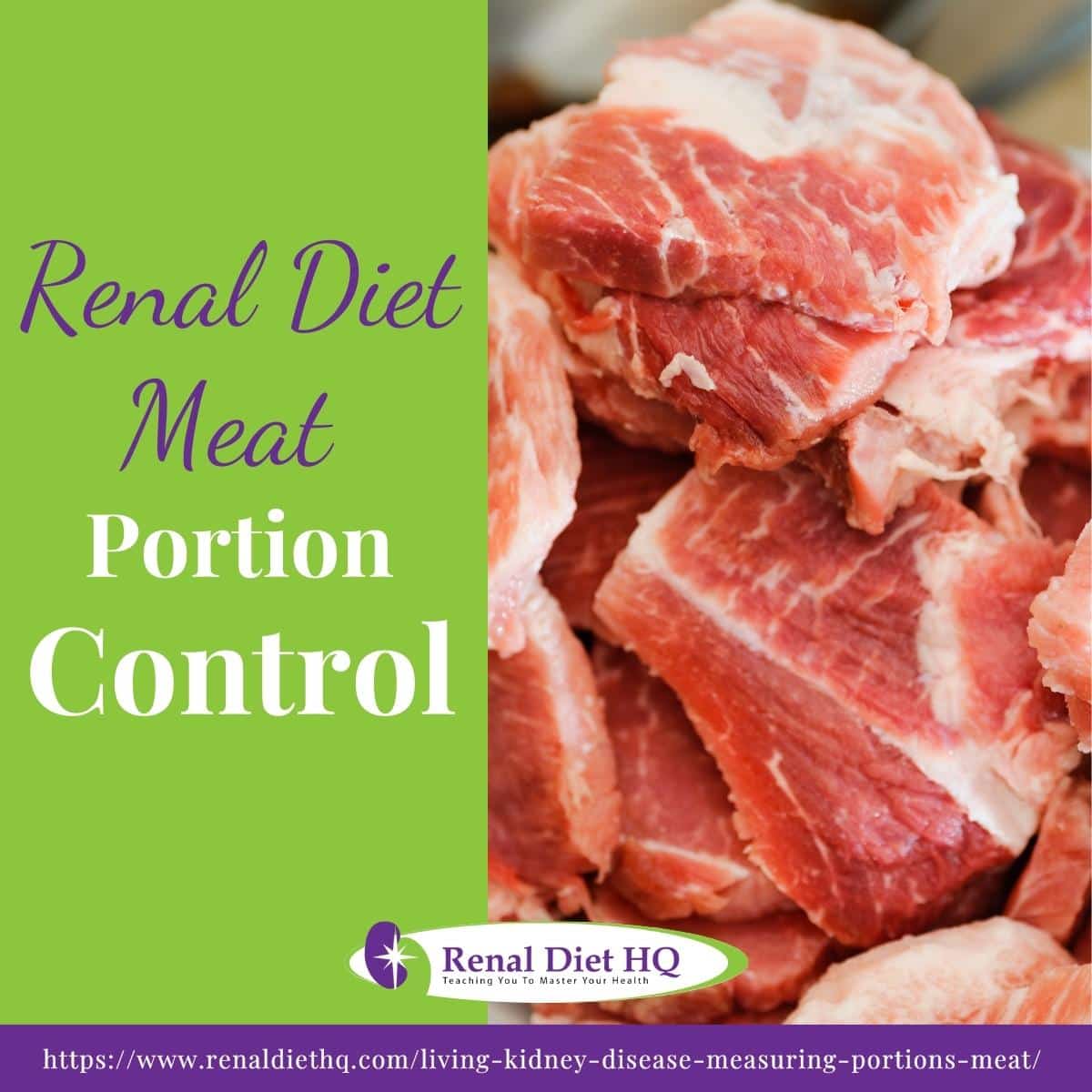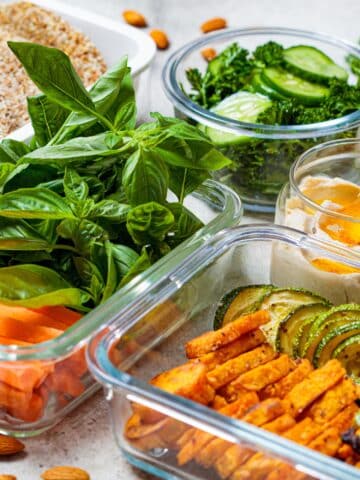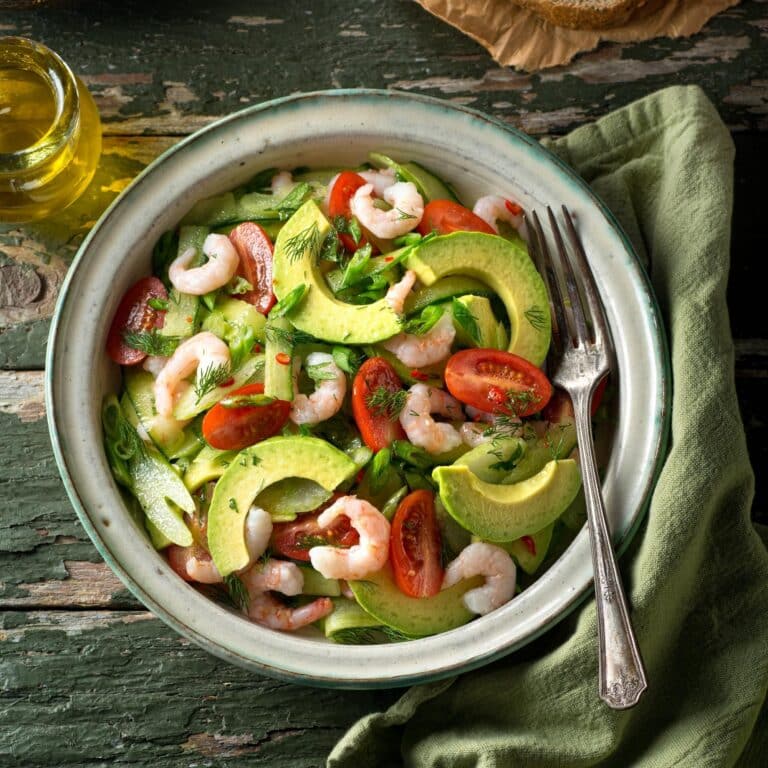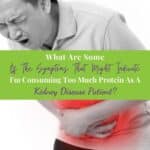Renal Diet Meat Portion Control
If you're managing chronic kidney disease (CKD), you know how crucial your diet is, particularly your protein intake. That's why it's vital to understand the importance of portion control, especially when it comes to meat.
Consuming too much protein can exacerbate your condition and further strain your kidneys. But don't worry, this doesn't mean you have to give up on meats altogether - it's all about moderation! This article aims to offer guidance on serving sizes for different types of meats, how other protein sources like beans and dairy products affect and are good for kidney health, and how to balance protein intake effectively.

Remember that everyone's needs are unique depending on the stage of their disease. Always consult with a health care provider for personalized dietary recommendations that are right for you.
Let's take a closer look at renal diet meat portion control so you can continue enjoying meals while keeping your kidneys healthy.
Jump to:
- Key Takeaways
- Understanding the Role of Protein in Chronic Kidney Disease
- The Importance of Portion Control in a Renal Diet
- How Protein Overload Affects the Kidneys
- Determining the Correct Portion Sizes for Meat
- How Chronic Kidney Disease Stages Influence Diet
- The Role of a Nutritionist in Managing Kidney Disease
- Daily Serving Recommendations for Meat, Fish, and Poultry
- Considering Meat Substitutes in a Renal Diet
- Monitoring Other Protein Sources in a Renal Diet
- Beans, Legumes, and Dairy Products on a Renal Diet for Kidney Health
- Consulting with Your Doctor for Personalized Dietary Recommendations
- Frequently Asked Questions
- On A Renal Diet, The Right Portion Control for Meat Meets Your Protein Needs
Key Takeaways
- Protein intake is crucial for managing chronic kidney disease, but moderation is key.
- Meat should be consumed in smaller portions to avoid straining the kidneys.
- Meat alternatives like tofu or tempeh can provide sufficient nutrition without causing additional strain on the kidneys.
- Determining portion sizes for meat is critical in a renal diet, with the palm-sized serving as a guideline.
For More Recipes and Ideas --->> Get Your Free Meals and Recipes That Are Perfect for Pre-Dialysis Diets, Pre-Dialysis with Diabetes, or Dialysis Diets.
Understanding the Role of Protein in Chronic Kidney Disease
Protein plays a complex role in chronic kidney disease management. While protein is an essential nutrient for overall health, individuals with CKD need to carefully monitor their protein intake due to the impaired ability of the kidneys to filter waste products.
In the early stages of CKD, protein restriction may not be necessary. However, as the disease progresses, reducing protein intake becomes important to slow down the decline in kidney function and reduce the risk of complications.
High protein intake can increase the workload on the kidneys and lead to the accumulation of waste products in the blood, putting additional strain on the already compromised kidneys.
The recommended protein intake for individuals with CKD is typically lower than that for healthy individuals. The specific protein requirement varies depending on the stage of CKD, level of kidney function, and individual factors such as age, body mass, and presence of other health conditions.
Protein quality is also crucial in CKD. High-quality protein sources, such as lean fresh meats, fish, poultry, and dairy products, provide essential amino acids without excessive waste products. These sources are generally preferred over lower-quality protein sources, such as processed deli meats, which can contribute to increased waste accumulation and potential harm to the kidneys.
In some cases, individuals with CKD may require dietary protein supplementation or specialized medical nutrition therapy to meet their specific protein needs while minimizing kidney damage.
It is essential for individuals with CKD to work closely with a registered dietitian or health care provider experienced in kidney disease to develop an individualized meal plan that balances protein intake with other dietary considerations.
Regular monitoring of kidney function and ongoing adjustments to protein intake are necessary to optimize nutrition and manage kidney disease progression.

The Importance of Portion Control in a Renal Diet
Portion control is crucial in a renal diet for individuals with chronic kidney disease (CKD). Controlling portion sizes helps manage the daily intake of nutrients, especially protein, sodium, phosphorus, and potassium, which are often restricted in a renal diet.
Proper portion control helps prevent overconsumption of protein, which can put additional strain on the kidneys and contribute to the accumulation of waste products. It also helps regulate sodium intake, as excessive sodium can lead to fluid retention and increased blood pressure, both of which can worsen kidney function.
Additionally, portion control helps manage phosphorus and potassium levels, as high levels of these minerals can be harmful to individuals with CKD.
To practice portion control, it is essential to be mindful of serving sizes and use measuring tools to accurately portion out food. Reading food labels and understanding serving sizes indicated can be helpful in maintaining portion control. Using smaller plates and bowls can also create an illusion of larger portions while still controlling the amount of food consumed.
Keeping tabs on the amount of protein you consume each day is absolutely crucial when dealing with kidney disease. Understanding your protein needs and being mindful of portion control in a renal diet can go a long way in preserving kidney function. The importance of portion control in a renal diet cannot be overstated.
Here's a simple guideline to help you visualize appropriate serving sizes:
| Food | Serving Size |
| Meat | Palm-sized piece |
| Beans/Legumes | Half-cup cooked |
| Dairy Products | One cup |
Remember, these are general recommendations, and individual needs may vary. That's why meal planning tips from professionals can be incredibly beneficial.
Working with a registered dietitian experienced in renal nutrition is recommended to receive personalized guidance on portion control and meal planning. They can provide recommendations on appropriate serving sizes and help individuals with CKD make informed choices that support their kidney health and overall well-being.
How Protein Overload Affects the Kidneys
Protein overload can have detrimental effects on the kidneys, especially for individuals with chronic kidney disease. The kidneys play a crucial role in filtering waste products and maintaining the balance of fluids and electrolytes in the body.
When there is an excessive intake of protein, it puts additional stress on the kidneys, which may worsen the progression of kidney disease. In individuals with CKD, the impaired kidney function reduces the kidneys' ability to efficiently filter and excrete waste products, including the byproducts of protein metabolism such as urea and creatinine.
As a result, these waste products can accumulate in the blood, leading to a condition known as azotemia. This can cause symptoms like fatigue, nausea, and decreased appetite.
Moreover, a high protein intake can increase the production of nitrogenous waste products, which need to be excreted by the kidneys. This process requires the kidneys to work harder and can further compromise their function.
Excessive protein intake can also contribute to the development of kidney stones, as certain waste products derived from protein metabolism can promote stone formation. For individuals with CKD, it is essential to follow a controlled protein diet prescribed by a healthcare professional or registered dietitian.
The recommended protein intake in a renal diet is based on the stage of CKD and the individual's nutritional needs. By carefully managing protein intake, the workload on the kidneys can be reduced, allowing them to function more effectively and potentially slowing down the progression of kidney disease.
It is important for individuals with CKD to work closely with their healthcare team to determine the appropriate level of protein intake and receive personalized guidance on nutrition to support their kidney health.
Determining the Correct Portion Sizes for Meat
Determining the correct portion sizes for meat intake while managing amounts of protein consumed for people with kidney disease is crucial to maintain kidney health. Protein is an essential nutrient, but it needs to be controlled in individuals with CKD to reduce the burden on the kidneys. Here are some strategies to determine appropriate portion sizes for meat:
- Consult a registered dietitian: Working with a registered dietitian who specializes in CKD can provide personalized guidance on protein intake and portion sizes. They will consider your individual needs, stage of CKD, and other factors to develop a meal plan that aligns with your nutritional requirements.
- Use the palm rule: A simple method to estimate portion sizes is using your hand as a guide. A serving of meat should be about the size and thickness of your palm. This method provides a general guideline for portion control.
- Weigh and measure: For more precise control over protein intake, weighing and measuring portions can be helpful. Use a kitchen scale to weigh meat before cooking to ensure accuracy. Measuring cups and spoons can be used for cooked or ground meats.
- Consider protein content: Different types of meats have varying protein content. Lean types of protein like skinless poultry, fish, and lean cuts of beef or pork are generally preferred for individuals with CKD. These options can be incorporated into meal plans while managing protein intake.
- Balance with other protein sources: It's important to consider protein from sources other than meat. Incorporating plant-protein foods like beans, lentils, tofu, and quinoa can help diversify protein sources and reduce reliance on animal protein foods.
Remember to discuss portion sizes and protein intake with your healthcare team. They will consider your specific needs and provide personalized recommendations to help you manage your CKD while maintaining adequate nutrition. Regular monitoring of kidney function and working closely with a healthcare professional will ensure that you're on the right track with your protein intake and portion control.
How Chronic Kidney Disease Stages Influence Diet
As a person's chronic kidney disease progresses through its various stages, what they can and cannot eat tends to shift significantly. This is where understanding the influence of renal diet on kidney function becomes crucial.
| CKD Stage | Protein Intake | Sodium Limit | Hydration |
| 1-2 | Moderate | Low | High |
| 3 | Lower | Very Low | High |
| 4 | Very Low | Minimal | Moderate |
| 5 | Minimal/Increased | Minimal | Low |
Diet plays a crucial role in managing chronic kidney disease (CKD), and the specific recommendations for protein, sodium, and fluid intake vary depending on the stage of the disease.
As CKD progresses, the kidneys' ability to filter waste and fluid decreases, necessitating adjustments in the diet to support kidney function. Here is how the stages of CKD influence diet:
In the early stages of CKD (stages 1-3), protein intake is generally maintained at a normal level, unless there are specific complications or conditions. Sodium intake may be limited to help control blood pressure and reduce fluid retention. Fluid intake is typically not restricted at this stage unless there is evidence of fluid overload.
As CKD progresses to stage 4, protein intake may need to be reduced to lessen the burden on the kidneys. The amount of protein recommended is often individualized based on factors such as the degree of kidney function decline, nutritional status, and other health conditions.
Sodium intake is further restricted to help manage blood pressure and fluid balance. Fluid intake may be more closely monitored and limited, especially if there is evidence of fluid retention or edema.
In stage 5 of CKD, also known as end-stage renal disease (ESRD) or end stage kidney disease, when the patient undergoes dialysis, protein needs may increase due to losses during dialysis treatments. Protein losses can occur during dialysis, so a higher protein intake is recommended to compensate for these losses and maintain adequate nutrition.
Sodium and fluid restrictions are still important to manage blood pressure and fluid overload, but the specifics may vary depending on the individual's condition and the type of dialysis they receive.
It is important to note that the dietary recommendations for CKD are highly individualized, and it is crucial to work closely with a registered dietitian or healthcare professional who specializes in kidney disease. They can provide personalized guidance based on the stage of CKD, nutritional needs, and other health considerations to optimize dietary management and support overall kidney health.
The Role of a Nutritionist in Managing Kidney Disease
Transitioning from understanding how various stages of chronic kidney disease influence your diet, it's crucial to delve deeper into the role a nutritionist plays in managing kidney health.
Nutritionists are invaluable for providing personalized dietary advice tailored to your specific condition and needs. As you navigate through your journey with renal disease, a nutritionist can guide you in several ways:
- They offer expert dietary guidance, helping you understand what foods to include or limit.
- They assist with meal planning by suggesting portion sizes for meat and other protein sources. This is vital as excessive protein can be harmful to kidneys.
- Nutritionists provide personalized recommendations considering your overall health and stage of kidney disease.
- They educate on the importance of maintaining ideal weight and controlling blood pressure – both essential in managing kidney disease.
The role of a nutritionist goes beyond just prescribing a diet chart. By offering comprehensive support, they contribute significantly towards managing kidney disease, ensuring that you're not only following the right diet but also understanding its impact on your body. Remember, every step taken under their guidance leads towards better renal health!
Daily Serving Recommendations for Meat, Fish, and Poultry
For individuals with chronic kidney disease who need to manage their protein intake, it is important to consider the daily serving recommendations for meat, fish, and poultry. These recommendations help ensure that patients receive adequate protein while controlling the overall amount.
The daily serving recommendations for protein sources in chronic kidney disease patients can vary depending on the stage of the disease, individual needs, and the advice of a healthcare professional. Generally, a serving of meat, fish, or poultry is considered to be around 3-4 ounces, which is approximately the size of a deck of cards.
For individuals with kidney disease, it is recommended to choose lean protein sources to minimize the intake of saturated fats and cholesterol. Examples of lean protein options include skinless poultry, fish (such as salmon, cod, or tuna), and lean cuts of meat (such as beef tenderloin or pork loin).
In terms of frequency, chronic kidney disease patients may aim for two to three servings of lean protein per day. However, this can vary based on individual needs and dietary restrictions. It is crucial to work with a registered dietitian or healthcare professional to determine the appropriate serving sizes and frequencies for protein intake, as they will take into account factors such as the patient's stage of CKD, nutritional status, and other health conditions.
Additionally, patients should consider alternative protein sources to diversify their diet and minimize the reliance on animal products. This can include incorporating plant-based protein sources such as legumes, tofu, tempeh, or seitan into their meals. These sources are lower in phosphorus and can provide valuable nutrients while helping to meet protein needs.
By following the recommended daily serving sizes for meat, fish, and poultry and considering alternative protein sources, CKD patients can maintain an appropriate protein intake while supporting their kidney health. Regular monitoring of kidney function and working closely with healthcare professionals will ensure that dietary recommendations are tailored to each individual's specific needs.

Considering Meat Substitutes in a Renal Diet
Incorporating meat substitutes like tofu, tempeh, and veggie burgers into a renal diet requires careful consideration to ensure they align with the specific dietary restrictions and nutritional needs of individuals with chronic kidney disease. Here are some important considerations when incorporating these options:
- Protein Source and Quality: Tofu and tempeh are excellent plant-based protein sources that provide high-quality protein with fewer phosphorus and potassium concerns compared to some processed meat substitutes. They can be a suitable choice for individuals with CKD who need to limit their phosphorus and potassium intake. On the other hand, processed meat substitutes like veggie burgers may contain higher levels of phosphorus, potassium, and sodium. It's important to read the nutrition labels and choose options that are lower in these minerals and sodium.
- Sodium and Additives: Processed meat substitutes, including veggie burgers, can contain amounts of sodium and phosphorus additives. Excess sodium intake can contribute to fluid retention and increased blood pressure. Look for low-sodium or sodium-free options and be cautious of additives and preservatives that may contain phosphates or phosphoric acid.
- Phosphorus and Potassium Levels: While tofu and tempeh are generally lower in phosphorus and potassium, processed meat substitutes like veggie burgers can vary in their mineral content. Choose veggie burgers that are specifically formulated for individuals with renal restrictions or look for options that are lower in phosphorus and potassium. Check ingredient labels for additive phosphorus content.
- Individual Tolerability: Each person may have different tolerances and preferences when it comes to meat substitutes. Some individuals with CKD may find that tofu and tempeh are better tolerated and provide a more natural and unprocessed source of protein. However, others may enjoy the convenience and taste of veggie burgers. It's important to listen to your body and choose options that are well tolerated and enjoyable.
- Portion Control: Regardless of the meat substitute chosen, portion control is essential. Even lower phosphorus and potassium options should be consumed in moderation to avoid overloading the kidneys. Consulting with a registered dietitian or healthcare professional can provide personalized guidance on appropriate portion sizes and incorporation of these meat substitutes into the renal diet.
By considering these factors and working closely with a healthcare professional, individuals with CKD can make informed choices about incorporating meat substitutes into their renal diet. Regular monitoring of kidney function and other relevant health markers will help guide dietary recommendations and ensure optimal management of CKD.
Monitoring Other Protein Sources in a Renal Diet
In a low-protein renal diet, it is important to carefully monitor other sources of protein, including beans, legumes, dairy products, eggs, and any other foods that contain protein. Here are some considerations for incorporating these protein sources into a low-protein renal diet:
- Beans and Legumes: Beans and legumes are rich in protein, fiber, and other nutrients. However, they also contain phosphorus and potassium, which should be limited in a renal diet. Choose lower phosphorus and potassium varieties, such as green beans, snap peas, or lentils, and consume them in moderation. Soaking and rinsing beans before cooking can help reduce their phosphorus content.
- Dairy Products: Dairy products provide protein and calcium but can also be high in phosphorus and potassium. Opt for low-phosphorus options like skim or low-fat milk, yogurt, or cheese. It is important to monitor portion sizes and consider the overall phosphorus and potassium intake from dairy products.
- Eggs: Eggs are a good source of high-quality protein and are generally well-tolerated in a low-protein renal diet. They are low in phosphorus and potassium. However, if an individual has specific dietary restrictions or other conditions, such as high cholesterol, it is advisable to consult with a healthcare professional for personalized guidance.
- Other Protein-Rich Foods: Poultry, lean meats, fish, and seafood can be included in a low-protein renal diet but should be selected carefully. Choose lean cuts, remove the skin from poultry, and avoid processed meats that are high in sodium and phosphorus. Monitoring portion sizes and considering the overall protein intake from these sources is essential.
- Personalized Guidance: It is important to work closely with a registered dietitian or healthcare professional to determine the appropriate amount of protein allowed in a low-protein kidney diet. They can provide specific recommendations based on the stage of CKD, individual nutritional needs, and any other health conditions.
By monitoring and managing the intake of protein-rich foods in a low-protein renal diet, individuals can meet their nutritional needs while minimizing the workload on the kidneys. Following a customized meal plan and regular monitoring of kidney function are crucial for maintaining optimal health and managing kidney disease effectively.
Beans, Legumes, and Dairy Products on a Renal Diet for Kidney Health
Here are a few recipe ideas for a kidney diet that incorporate beans, legumes, and dairy products while being mindful of the protein content based on the stage of kidney disease:
- Lentil Salad:
- Cooked green or brown lentils, diced cucumbers, cherry tomatoes, and chopped parsley.
- Dress with a mixture of lemon juice, olive oil, and pepper.
- Add crumbled low-fat feta cheese as desired.
- Chickpea and Vegetable Stir-Fry:
- Sauté a mix of chopped vegetables like bell peppers, zucchini, and broccoli in a small amount of olive oil.
- Add cooked chickpeas and season with low-sodium soy sauce or a dash of herbs and spices.
- Serve over a bed of steamed brown rice or quinoa.
- Greek Yogurt Parfait:
- Layer low-fat Greek yogurt, sliced fresh fruits like strawberries or blueberries, and crushed low-phosphorus granola in a glass.
- Repeat the layers and top with a drizzle of honey or a sprinkle of cinnamon.
- Spinach and Ricotta Stuffed Shells:
- Cook jumbo pasta shells according to package instructions.
- In a bowl, mix low-fat ricotta cheese, cooked spinach, garlic, and herbs.
- Stuff the cooked shells with the mixture and place in a baking dish.
- Top with a low-sodium tomato sauce and sprinkle with grated low-phosphorus cheese.
- Bake until heated through and the cheese is melted.
- Creamy White Bean Soup:
- Sauté chopped onions, carrots, and celery in olive oil until tender.
- Add cooked white beans, low-sodium vegetable broth, and herbs like thyme and bay leaves.
- Simmer until flavors meld together, then blend until smooth.
- Serve with a sprinkle of chopped parsley on top.
Remember to adjust portion sizes and ingredients based on individual dietary needs and the specific recommendations provided by a registered dietitian or healthcare professional. These recipes provide a starting point for incorporating beans, legumes, and dairy products into a kidney diet while being mindful of the protein content.
Consulting with Your Doctor for Personalized Dietary Recommendations
Understanding your unique dietary needs when dealing with kidney disease can feel overwhelming, but remember, you're not alone in this journey - your doctor is there to guide and support you with personalized medical advice tailored just for you. They understand the intricacies of renal nutrition and can provide clear and concise explanations to help manage your kidney disease dietary restrictions.
Here are four steps that you can take:
- Prioritize regular appointments with your medical professional.
- Discuss any concerns or changes in your health status promptly.
- Ask about individualized dietary recommendations based on your current condition.
- Follow through on these strategies under their close supervision.
Remember, every patient's condition varies; thus, personalized meal planning becomes crucial in managing kidney disease effectively. Consulting professionals helps ensure the protein intake from meat or other sources is within permissible limits while still meeting nutritional requirements.
Your doctor's guidance plays an integral role in maintaining a balance between enjoying what you eat and adhering to necessary dietary modifications for kidney health management. So keep those lines of communication open with them, respect their advice as they champion serving your best interests – because managing renal diet doesn't have to be a solitary task after all!
Frequently Asked Questions
No, different cooking methods do not generally affect the protein content of foods. Proteins are composed of complex structures that are resistant to significant changes during cooking.
While cooking methods can impact the texture, taste, and overall quality of protein-rich foods, they typically do not alter the protein content itself. However, it is important to note that excessive heat, prolonged cooking times, or cooking at very high temperatures can lead to some protein denaturation or degradation.
To maximize protein retention, it is recommended to choose cooking methods that are gentle, such as steaming, boiling, baking, or poaching, and to avoid excessive cooking times or high temperatures. Proper handling and cooking techniques are crucial to maintain the nutritional value of protein-rich foods.
When preparing meat for a renal diet, it is important to be mindful of the seasonings and condiments used. It is advisable to avoid or limit the use of seasonings and condiments that are high in sodium, as excessive sodium intake can contribute to fluid retention and increase blood pressure.
Some common high-sodium seasonings and condiments to avoid or use sparingly include regular table salt, soy sauce, teriyaki sauce, barbecue sauce, and commercially prepared spice blends or seasoning mixes that contain added amounts of salt. Instead, it is recommended to opt for low-sodium or salt-free alternatives, such as herbs, spices, lemon juice, vinegar, garlic, ginger, and other natural flavor enhancers, to add taste and flavor to the meat without significantly increasing sodium intake.
It is important to read labels carefully and choose low-sodium or salt-free versions of seasonings and condiments to ensure adherence to a renal diet. Working with a registered dietitian or healthcare professional can provide personalized guidance on suitable seasonings and condiments for a renal diet based on individual dietary needs and restrictions.
Some symptoms that may indicate excessive protein intake as a kidney disease patient include increased thirst, swelling in the body, changes in urine (foamy or frothy), fatigue, decreased appetite, and digestive issues such as bloating or constipation.
These symptoms can vary depending on the individual and the stage of kidney disease. It's important to consult with a healthcare professional or registered dietitian specializing in kidney disease to assess your protein intake and make necessary dietary adjustments.
For kidney patients with comorbid conditions like high blood pressure, diabetes, and the like, the protein requirement may vary depending on individual health needs. In general, the protein requirement for these patients may be lower compared to those without these conditions. This is because excessive protein intake can put additional strain on the kidneys and may worsen the progression of kidney disease.
However, it is crucial to work with a healthcare professional or registered dietitian who specializes in kidney disease to determine the specific protein needs based on the individual's overall health, kidney function, and specific comorbidities. They will consider factors such as blood sugar control, blood pressure management, and other dietary considerations to develop a personalized meal plan that supports optimal health while minimizing the risk of complications.
Doctors may request several laboratory tests to monitor protein intake for patients with chronic kidney disease (CKD). These tests include:
1. Serum Creatinine: Measures the level of creatinine in the blood, which indicates kidney function and helps determine the appropriate amount of dietary protein.
2. Blood Urea Nitrogen (BUN): Evaluates the level of urea nitrogen in the blood, which can indicate protein metabolism and kidney function.
3. Urine Protein: Measures the amount of protein excreted in the urine, helping assess kidney damage and protein leakage.
4. Serum Albumin: Assesses the level of albumin, a protein synthesized by the liver, which reflects nutritional status and kidney function.
These tests provide valuable information for healthcare providers to monitor protein intake and make necessary adjustments to the dietary plan for patients with CKD. Regular monitoring of these markers helps optimize nutritional management and prevent protein-related complications in individuals with kidney disease. It's crucial for patients to collaborate closely with their healthcare team to interpret the results and implement appropriate dietary modifications based on their specific needs.
On A Renal Diet, The Right Portion Control for Meat Meets Your Protein Needs
Successfully managing protein intake in a renal diet necessitates careful attention to portion sizes and protein sources. The impact of different stages of chronic kidney disease on dietary recommendations must be understood, and moderation is essential when consuming meat.
Incorporating meat alternatives like tofu and tempeh can provide adequate nutrition without adding excessive strain to the kidneys. Other protein sources, such as beans, legumes, dairy products, and eggs, should be monitored, considering their phosphorus, potassium, and sodium content.
Individuals with CKD and other health conditions should seek personalized guidance from healthcare professionals. Avoiding high-sodium or high-phosphorus seasonings and condiments is advisable when preparing meat for a renal diet. Regular monitoring of protein intake through laboratory tests is crucial.
Overall, a comprehensive approach, including portion control, diverse protein sources, and professional guidance, is essential for a successful renal diet.














